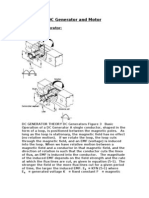0 ratings0% found this document useful (0 votes)
203 viewsVan de Graff
Van de Graff
Uploaded by
ReymondA Van de Graaff generator uses a moving belt to accumulate a very high electrical charge on a hollow metal globe at the top of the stand. It was invented by American physicist Robert J. Van de Graaff in 1929. Modern Van de Graaff generators can produce voltages over 5 megavolts. They are used to accelerate subatomic particles for nuclear physics experiments and other applications.
Copyright:
© All Rights Reserved
Available Formats
Download as ODT, PDF, TXT or read online from Scribd
Van de Graff
Van de Graff
Uploaded by
Reymond0 ratings0% found this document useful (0 votes)
203 views4 pagesA Van de Graaff generator uses a moving belt to accumulate a very high electrical charge on a hollow metal globe at the top of the stand. It was invented by American physicist Robert J. Van de Graaff in 1929. Modern Van de Graaff generators can produce voltages over 5 megavolts. They are used to accelerate subatomic particles for nuclear physics experiments and other applications.
Original Description:
xxxxxx
Copyright
© © All Rights Reserved
Available Formats
ODT, PDF, TXT or read online from Scribd
Share this document
Did you find this document useful?
Is this content inappropriate?
A Van de Graaff generator uses a moving belt to accumulate a very high electrical charge on a hollow metal globe at the top of the stand. It was invented by American physicist Robert J. Van de Graaff in 1929. Modern Van de Graaff generators can produce voltages over 5 megavolts. They are used to accelerate subatomic particles for nuclear physics experiments and other applications.
Copyright:
© All Rights Reserved
Available Formats
Download as ODT, PDF, TXT or read online from Scribd
Download as odt, pdf, or txt
0 ratings0% found this document useful (0 votes)
203 views4 pagesVan de Graff
Van de Graff
Uploaded by
ReymondA Van de Graaff generator uses a moving belt to accumulate a very high electrical charge on a hollow metal globe at the top of the stand. It was invented by American physicist Robert J. Van de Graaff in 1929. Modern Van de Graaff generators can produce voltages over 5 megavolts. They are used to accelerate subatomic particles for nuclear physics experiments and other applications.
Copyright:
© All Rights Reserved
Available Formats
Download as ODT, PDF, TXT or read online from Scribd
Download as odt, pdf, or txt
You are on page 1of 4
Opea, Reymart Lou B. Mr.
Goffer Augustine Yagonia
Van de Graaff generator
This article is about the machine used to accumulate electrical charge on a metal globe. For the progressive rock
band with a similar name, see Van der Graaf Generator.
Van de Graaff generator
Van de Graaff generator.
Uses
Accelerating electrons to sterilize food and process materials,
acceleratingprotons for nuclear pysicse!periments, dri"ing #$ray tu%es, etc.
Inventor Ro%ert &. Van de Graaff
Related
items
Van de Graaff, linear particle accelerator
A Van de Graaff generator is an electrostatic generator 'ic uses a mo"ing %elt to accumulate "ery ig amounts
of electrical potential on a ollo' metal glo%e on te top of te stand. (t 'as in"ented %y American pysicist Ro%ert &.
Van de Graaff in )*+*. ,e potential difference acie"ed in modern Van de Graaff generators can reac - mega"olts.
A ta%letop "ersion can produce on te order of )..,... "olts and can store enoug energy to produce a "isi%le spar/.
A Van de Graaff generator operates %y transferring electric carge from a mo"ing %elt to a terminal. 0irst in"ented in
)*+*, te Van de Graaff generator %ecame a source of ig "oltage for accelerating su%atomic particles to ig speeds,
ma/ing it a useful tool for fundamental pysics researc.
A simple Van de Graaff$generator consists of a %elt of sil/, or a similar fle!i%le dielectric material, running o"er
t'o metal pulleys, one of 'ic is surrounded %y a ollo' metal spere.1)2 ,'o electrodes, 3+4 and 354, in te
form of com%$saped ro's of sarp metal points, are positioned respecti"ely near to te %ottom of te lo'er
pulley and inside te spere, o"er te upper pulley. 6om% 3+4 is connected to te spere, and com% 354 to te
ground. A ig 76 potential 3'it respect to eart4 is applied to roller 3849 a positi"e potential in tis e!ample.
As te %elt passes in front of te lo'er com%, it recei"es negati"e carge tat escapes from its points due to te
influence of te electric field around te lo'er pulley, 'ic ionizes te air at te points. As te %elt touces te
lo'er roller 3:4, it transfers some electrons, lea"ing te roller 'it a negati"e carge 3if it is insulated from te
terminal4, 'ic added to te negati"e carge in te %elt generates enoug electric field to ionize te air at te
points of te upper com%. ;lectrons ten lea/ from te %elt to te upper com% and to te terminal, lea"ing te
%elt positi"ely carged as it returns do'n and te terminal negati"ely carged. ,e spere sields te upper
roller and com% from te electric field generated %y carges tat accumulate at te outer surface of it, causing te
discarge and cange of polarity of te %elt at te upper roller to occur practically as if te terminal 'ere
grounded. As te %elt continues to mo"e, a constant <carging current< tra"els "ia te %elt, and te spere
continues to accumulate negati"e carge until te rate tat carge is %eing lost 3troug lea/age and corona
discarges4 e=uals te carging current. ,e larger te spere and te farter it is from ground, te iger 'ill %e
its final potential.
Anoter metod for %uilding Van de Graaff generators is to use te tri%oelectric effect. ,e friction %et'een te
%elt and te rollers, one of tem no' made of insulating material, or %ot made 'it insulating materials at
different positions on te tri%oelectric scale, one a%o"e and oter %elo' te material of te %elt, carges te
rollers 'it opposite polarities. ,e strong e$field from te rollers ten induces a corona discarge at te tips of
te pointed com% electrodes. ,e electrodes ten >spray> a carge onto te %elt 'ic is opposite in polarity to
te carge on te rollers. ,e remaining operation is oter'ise te same as te "oltage$in?ecting "ersion a%o"e.
,is type of generator is easier to %uild for science fair or omemade pro?ects, since it does not re=uire a
potentially dangerous ig$"oltage source. ,e trade$off is tat it cannot %uild up as ig a "oltage as te oter
type, tat cannot also %e easily regulated, and operation may %ecome difficult under umid conditions 3'ic
can se"erely reduce tri%oelectric effects4. 0inally, since te position of te rollers can %e re"ersed, te
accumulated carge on te ollo' metal spere can eiter %e positi"e or negati"e.
A Van de Graaff generator terminal does not need to %e spere$saped to 'or/, and in fact, te optimum sape is
a spere 'it an in'ard cur"e around te ole 'ere te %elt enters. @ince electrically carged conductors a"e
no e$field inside, carges can %e added continuously. A rounded terminal minimizes te electric field around it,
allo'ing greater potentials to %e acie"ed 'itout ionization of te surrounding air, or oter dielectric gas.
Outside te spere, te e$field =uic/ly %ecomes "ery strong and applying carges from te outside 'ould soon
%e pre"ented %y te field.
@ince a Van de Graaff generator can supply te same small current at almost any le"el of electrical potential, it is
an e!ample of a nearly ideal current source. ,e ma!imum acie"a%le potential is appro!imately e=ual to te
spere<s radius multiplied %y te e$field 'ere corona discarges %egin to form 'itin te surrounding gas. 0or
e!ample, a polised sperical electrode 8. cm in diameter immersed in air at @,A 3'ic as a %rea/do'n
"oltage of a%out 8. /VBcm4 could %e e!pected to de"elop a ma!imum "oltage of a%out C-. /V.
History
,e fundamental idea for te friction macine as ig$"oltage supply, using electrostatic influence to carge
rotating dis/ or %elt, can %e traced %ac/ to te )5t century or e"en %efore 3cf. 0riction macines Distory4
,e Van de Graaff generator 'as de"eloped, starting in )*+*, %y pysicist Ro%ert &. Van de
Graaff at Arinceton Eni"ersity 'it elp from colleague Ficolas Bur/e. ,e first model 'as demonstrated
in Octo%er )*+*.1+2 ,e first macine used a sil/ ri%%on %ougt at a fi"e$and$dime store as te carge
transport %elt. (n )*8), a "ersion a%le to produce ),...,... "olts 'as descri%ed in a patent disclosure. ,is
"ersion ad t'o :.$cm$diameter carge$accumulation speres mounted on %orosilicate glass columns
)G. cm ig9 te apparatus cost only H*. in )*8).182
Van de Graaff applied for a patent in 7ecem%er )*8), 'ic 'as assigned to M(, in e!cange for a sare
of net income. ,e patent 'as later granted.
(n )*88, Van de Graaff %uilt a C.$foot 3)+$m4 model at M(,<s Round Dill facility, te use of 'ic 'as
donated %y 6olonel ;d'ard D. R. Green.
A more recent de"elopment is te tandem Van de Graaff accelerator, containing one or more Van de
Graaff generators, in 'ic negati"ely carged ions are accelerated troug one potential difference %efore
%eing stripped of t'o or more electrons, inside a ig "oltage terminal, and accelerated again. An e!ample
of a tree$stage operation as %een %uilt in O!ford Fuclear La%oratory in )*:C of a ). MV single$ended
>in?ector> and a : MV ;F tandem.1C2
One of Van de Graaff<s accelerators used t'o carged domes of sufficient size tat eac of te domes ad
la%oratories inside $ one to pro"ide te source of te accelerated %eam, and te oter to analyze te actual
e!periment. ,e po'er for te e=uipment inside te domes came from generators tat ran off te %elt, and
se"eral sessions came to a rater gruesome end 'en a pigeon 'ould try to fly %et'een te t'o domes,
causing tem to discarge. 3,e accelerator 'as set up in an airplane angar.41-2
By te )*5.s, up to )C million "olts could %e acie"ed at te terminal of a tandem tat used a tan/ of ig$
pressure sulfur e!afluoride 3@0:4 gas to pre"ent spar/ing %y trapping electrons. ,is allo'ed te
generation of ea"y ion %eams of se"eral tens of megaelectron"olts, sufficient to study ligt ion direct
nuclear reactions. ,e igest potential sustained %y a Van de Graaff accelerator is +-.- MV, acie"ed %y
te tandem at te Dolifield Radioacti"e (on Beam 0acility at Oa/ Ridge Fational La%oratory.1citation
needed2
A furter de"elopment is te pelletron, 'ere te ru%%er or fa%ric %elt is replaced %y a cain of sort
conducti"e rods connected %y insulating lin/s, and te air$ionizing electrodes are replaced %y a grounded
roller and inducti"e carging electrode. ,e cain can %e operated at muc iger "elocity tan a %elt, and
%ot te "oltage and currents attaina%le are muc iger tan 'it a con"entional Van de Graaff generator.
,e )C E7 Dea"y (on Accelerator at ,e Australian Fational Eni"ersity ouses a )-$million$"olt pelletron.
(ts cains are more tan +. meters long and can tra"el faster tan -. /mBr.1:2
,e Fuclear @tructure 0acility 3F@04152 at 7ares%ury La%oratory 'as proposed in te )*5.s, commissioned
in )*G), and opened for e!periments in )*G8. (t consisted of a tandem Van de Graaff generator operating
routinely at +. MV, oused in a distincti"e %uilding 5. metres ig. 7uring its lifetime, it accelerated G.
different ion %eams for e!perimental use, ranging from protons to uranium. A particular feature 'as te
a%ility to accelerate rare isotopic and radioacti"e %eams. Aeraps te most important disco"ery made on te
F@0 'as tat of super$deformed nuclei. ,ese nuclei, 'en formed from te fusion of ligter elements,
rotate "ery rapidly. ,e pattern of gamma rays emitted as tey slo' do'n pro"ided detailed information
a%out te inner structure of te nucleus. 0ollo'ing financial cut%ac/s, te F@0 closed in )**8.
Van de Graaff generators on display
,e largest air$insulated Van de Graaff generator in te 'orld, %uilt %y 7r. Van de Graaff in te )*8.s,
is no' on permanent display at Boston<s Museum of @cience. Iit t'o con?oined C.-$meter 3)-$
foot4 aluminium speres standing on columns ++ feet 3:.5 m4 tall, tis generator can often reac + MV
3+ million "olts4. @o's using te Van de Graaff generator and se"eral ,esla coils are conducted t'o to
tree times a day. Many science museums, suc as te American Museum of @cience and ;nergy, a"e
small$scale Van de Graaff generators on display, and e!ploit teir static$producing =ualities to create
>ligtning> or ma/e people<s air stand up. Van de Graaff generators are also used in scools and in
science so's.
6omparison 'it oter ig$"oltage generators
Oter classical electrostatic macines li/e a Iimsurst macine or a Bonetti macine1G2 can easily
produce more current tan a Van de Graaff generator for e!periments 'it electrostatics, and a"e
positi"e and negati"e outputs. ,e less$insulated structures, o'e"er, result in smaller "oltages.
,e idea of %ringing small amounts of carge into te middle of a large metal container 'ere carge
can accumulate to large "alues is central to te operation of te "an de Graaff generator. ,e same
pysics is at 'or/ in te Jel"in 'ater dropper. (n tat de"ice, separate carged drops of 'ater fall
under gra"ity against same$carge %uc/ets, %uilding up carge. (n te "an de Graaff, small units of
carge on an insulating %elt ride into te large spere using e!ternal 'or/ pro"ided %y a motor.
References
).Jump up^ Van de Graaf biography
+.Jump up^ Article "Van de Graaf's Generator", in "Electrical Engineering Handbook", (ed)., CC
!ress, "oca aton, #lorida $%A, &''( )%"* +,-.'(,+&-/,-
8.Jump up^ 0. 1akacs, Energy Stabilization of Electrostatic Accelerators, 0ohn 2iley and %ons,
Chichester, &''3
C.Jump up^ http455666.7os.org5sln5toe5history.ht7l
-.Jump up^ http455666.an8.ed8.a85C%E957achines5Accelerator.ht7
:.Jump up^ 0 % :illey &'-; !hys. %cr. ;/ .(/,..; doi4&+.&+--5++(&,-'.'5;/5(5++&)
5.Jump up^ "1he "onetti electrostatic 7achine". 666.coe.8<r=.br. etrie>ed ;+&+,+',&..
You might also like
- regEM PDFDocument62 pagesregEM PDFkelectronNo ratings yet
- Wedding Day Questionnaire FormDocument10 pagesWedding Day Questionnaire Formhananiah100% (1)
- Van de Graaff GeneratorDocument5 pagesVan de Graaff GeneratorNathaniel MalabagNo ratings yet
- Van de Graff GeneratorDocument5 pagesVan de Graff Generatormanish_iitrNo ratings yet
- Vandegraff GeneratorDocument24 pagesVandegraff GeneratorVinayKumarNo ratings yet
- Chittagong University of Engineering and TechnologyDocument4 pagesChittagong University of Engineering and TechnologyMD. MAHADI HASAN SAJIB 1602124No ratings yet
- Two Main Principles of Van de Graff Generator Are Given BelowDocument3 pagesTwo Main Principles of Van de Graff Generator Are Given BelowSIDDHARTH7No ratings yet
- Vaan de Graaf GeneratorDocument16 pagesVaan de Graaf GeneratorImran_firdousiNo ratings yet
- Van de Graaff GeneratorDocument5 pagesVan de Graaff Generatorahmed s. NourNo ratings yet
- Van de Graaff GeneratorDocument12 pagesVan de Graaff GeneratorOnkar RaiNo ratings yet
- KelvinWaterDropGeneratorPhys13News MineDocument56 pagesKelvinWaterDropGeneratorPhys13News MineViesturs IgnatansNo ratings yet
- Static ElectricityDocument5 pagesStatic Electricitydunhamc100% (2)
- Generator Van de GraaffDocument6 pagesGenerator Van de GraaffDinar PinandhitaNo ratings yet
- Capacitive AntennaDocument8 pagesCapacitive AntennajohnleslieNo ratings yet
- Van de GraaffDocument4 pagesVan de GraaffMaeka SanvictoresNo ratings yet
- High Voltage Misconceptions - Static ElectricityDocument12 pagesHigh Voltage Misconceptions - Static ElectricityBraulio IrrutiaNo ratings yet
- Tesla Coil ProjectDocument58 pagesTesla Coil Projectvdahiya007No ratings yet
- Electrical ChargeDocument11 pagesElectrical ChargeMark Anthony Evangelista CabrietoNo ratings yet
- Technical LectrueDocument18 pagesTechnical Lectrueapi-285063980No ratings yet
- Single-Wire Electric Power Transmission: N.V. Kosinov, V.I. Garbaruk, UkraineDocument6 pagesSingle-Wire Electric Power Transmission: N.V. Kosinov, V.I. Garbaruk, UkraineDavide Tanner TainiNo ratings yet
- Rotating-Cylinder Electrostatic Generator With Hydrogen Insulation. N. J. Felici. The Soviet Journal of Atomic Energy, Volume 11, Pages 776-788, 1962Document13 pagesRotating-Cylinder Electrostatic Generator With Hydrogen Insulation. N. J. Felici. The Soviet Journal of Atomic Energy, Volume 11, Pages 776-788, 1962Ettel YuangNo ratings yet
- Lessons in Electric CircuitsDocument575 pagesLessons in Electric CircuitsBing WangNo ratings yet
- Bloch Waves Block StatesDocument5 pagesBloch Waves Block StatesTeka Kam100% (1)
- Letters: Observation of The Spin Seebeck EffectDocument4 pagesLetters: Observation of The Spin Seebeck Effectdharanihvac0% (1)
- Electrostatic GeneratorDocument8 pagesElectrostatic GeneratorChauncey AlexanderNo ratings yet
- Visual PreviewDocument4 pagesVisual PreviewjeovanevsNo ratings yet
- Wireless Power Transfer Via Strongly Coupled Magnetic ResonancesDocument11 pagesWireless Power Transfer Via Strongly Coupled Magnetic Resonancesapi-3805241100% (1)
- Electrostatics: Physics-MC/Electrostatics/By Lee Siu Hin Page 1 of 3Document3 pagesElectrostatics: Physics-MC/Electrostatics/By Lee Siu Hin Page 1 of 3eltytanNo ratings yet
- Electric Motor: Your Activity MaterialDocument6 pagesElectric Motor: Your Activity MaterialJoel Varghese ThomasNo ratings yet
- Chapter 13Document61 pagesChapter 13Stevan FarkasNo ratings yet
- Bob Neal Overunity Compression Unit - US2030759Document5 pagesBob Neal Overunity Compression Unit - US2030759John CarterNo ratings yet
- Significance of Back EmfDocument1 pageSignificance of Back Emfntrimurthulu100% (1)
- A System To Convert Gravitational Energy Directly Into Electrical EnergyDocument17 pagesA System To Convert Gravitational Energy Directly Into Electrical EnergyFran De AquinoNo ratings yet
- Van de GraffDocument11 pagesVan de GraffNigel LoboNo ratings yet
- Infinity Is Weird Even in Infinite ReactanceDocument6 pagesInfinity Is Weird Even in Infinite ReactanceVinyasiNo ratings yet
- HPT (Ieee, 2005)Document7 pagesHPT (Ieee, 2005)Muhammad Hadi MustajabNo ratings yet
- Chapter 1 Basic Ac Theory What Is Alternating Current (AC) ?Document19 pagesChapter 1 Basic Ac Theory What Is Alternating Current (AC) ?Jack MartinsonNo ratings yet
- Science Form 2: Electricity and MagnetismDocument32 pagesScience Form 2: Electricity and MagnetismRubiah BasriNo ratings yet
- Iso Exploded View: Revisions Rev. Description Date 00 Original IssueDocument1 pageIso Exploded View: Revisions Rev. Description Date 00 Original IssueParpala BogdanNo ratings yet
- Description of The Invention To The Patent: (Nineteen) Eleven) 13)Document11 pagesDescription of The Invention To The Patent: (Nineteen) Eleven) 13)Mihai DanielNo ratings yet
- DC Generator and MotorDocument7 pagesDC Generator and MotoranilkulalNo ratings yet
- AsdasdadsDocument9 pagesAsdasdadsCaps LockNo ratings yet
- Van de Graaff GeneratorDocument7 pagesVan de Graaff GeneratorJim100% (2)
- Azerbajian Device Translated From RuslanDocument7 pagesAzerbajian Device Translated From RuslanbluesurviverNo ratings yet
- Steven Mark TPU FAQ v1.0Document6 pagesSteven Mark TPU FAQ v1.0cimpocteNo ratings yet
- LTseung PDFDocument71 pagesLTseung PDFMAGUS43No ratings yet
- 01 - The Freerider Free Energy Inverter Rev 00DDocument18 pages01 - The Freerider Free Energy Inverter Rev 00Dpeterfoss791665No ratings yet
- United States: (12) Patent Application Publication (10) Pub. No.: US 2014/0253271 A1Document24 pagesUnited States: (12) Patent Application Publication (10) Pub. No.: US 2014/0253271 A1vali2daduica100% (1)
- 0102 - Forever Flasher PDFDocument3 pages0102 - Forever Flasher PDFMuhammadAsifNo ratings yet
- March 19, 1968 - R, Kromrey I 3,374,376: Electric GeneratorDocument8 pagesMarch 19, 1968 - R, Kromrey I 3,374,376: Electric GeneratorVlad AdrianNo ratings yet
- GP 12260Document2 pagesGP 12260api-170472102No ratings yet
- Barbosa and Leal Generator - How The Electron Move in The LoopDocument10 pagesBarbosa and Leal Generator - How The Electron Move in The LoopMihai Daniel100% (1)
- AN601 - Back EMF & Ground LoopsDocument6 pagesAN601 - Back EMF & Ground Loops권순태No ratings yet
- C1 0,02uf 2000V C2 0,02uf 2000V: Spark GapDocument2 pagesC1 0,02uf 2000V C2 0,02uf 2000V: Spark GapamanNo ratings yet
- Switz Russian SEG ReportDocument32 pagesSwitz Russian SEG ReportBoris MitovNo ratings yet
- Electrostatic AccelaratorDocument18 pagesElectrostatic AccelaratorPradeepNo ratings yet
- Ответы Дона СмитаDocument5 pagesОтветы Дона СмитаVasily VorobyovNo ratings yet
- Wireless Transmission of Electricity AbstractDocument7 pagesWireless Transmission of Electricity AbstractTapas Kumar Ojha67% (3)
- Application of Flexible AC Transmission System Devices in Wind Energy Conversion SystemsFrom EverandApplication of Flexible AC Transmission System Devices in Wind Energy Conversion SystemsNo ratings yet
- All Notes RevalidaDocument8 pagesAll Notes RevalidaReymondNo ratings yet
- Promissory NoteDocument1 pagePromissory NoteReymondNo ratings yet
- CHERRYDocument2 pagesCHERRYReymondNo ratings yet
- The Completion of Coupon and Service That They AvailedDocument1 pageThe Completion of Coupon and Service That They AvailedReymondNo ratings yet
- RLE Manual EditedDocument68 pagesRLE Manual EditedReymondNo ratings yet
- Reymond QDocument3 pagesReymond QReymondNo ratings yet
- Article Vi The Legislative DepartmentDocument2 pagesArticle Vi The Legislative DepartmentReymondNo ratings yet
- NATIONAL POWER CORPORATION, Petitioner, vs. CITY OF CABANATUAN, RespondentDocument10 pagesNATIONAL POWER CORPORATION, Petitioner, vs. CITY OF CABANATUAN, RespondentReymondNo ratings yet
- The Sun As Center of Universe, Earth As Center of UniverseDocument1 pageThe Sun As Center of Universe, Earth As Center of UniverseReymondNo ratings yet
- Who Am IDocument2 pagesWho Am IReymondNo ratings yet
- KibsDocument4 pagesKibsReymondNo ratings yet
- Real Estate MortgageDocument5 pagesReal Estate MortgageReymondNo ratings yet
- Jer ShiexxxxDocument1 pageJer ShiexxxxReymondNo ratings yet
- WBUR Poll: Angus King Heavy Favorite To Replace Sen. Snowe (Crosstabs)Document35 pagesWBUR Poll: Angus King Heavy Favorite To Replace Sen. Snowe (Crosstabs)WBURNo ratings yet
- DharmaDocument4 pagesDharmaJarrod GlandtNo ratings yet
- T02 - Capital BudgetingDocument107 pagesT02 - Capital BudgetingSuehNo ratings yet
- Romanization: 1St Album-The Shinee World 1. The Shinee WorldDocument49 pagesRomanization: 1St Album-The Shinee World 1. The Shinee WorldFeitrianiNo ratings yet
- Elements of Soil Mechanics, 8th Edition Bearing Capacity FactorsDocument14 pagesElements of Soil Mechanics, 8th Edition Bearing Capacity Factorsthiru2025No ratings yet
- Real Dating Format PDFDocument1 pageReal Dating Format PDFoghenevwedeemojevwe100% (1)
- Mass Decorum PDFDocument2 pagesMass Decorum PDFDhong ZamoraNo ratings yet
- Date Category Activity Cost For 2Document8 pagesDate Category Activity Cost For 2Haritsari DewiNo ratings yet
- SQ505638 - Aayan Al Nokhba-MVE Spare Parts-Rev-00Document10 pagesSQ505638 - Aayan Al Nokhba-MVE Spare Parts-Rev-00mostafa husseinNo ratings yet
- GTD Trigger ListDocument2 pagesGTD Trigger ListAmesNo ratings yet
- Final Report TH True Milk Group 2Document69 pagesFinal Report TH True Milk Group 2Thuý QuỳnhNo ratings yet
- Building-Integrated Solar TechnologyDocument140 pagesBuilding-Integrated Solar Technologysora.ysukNo ratings yet
- Tu Vung Tieng Thai Lan Theo Chu de Vo Chi Thanh 145x205 - Final - 166p Pages 2Document5 pagesTu Vung Tieng Thai Lan Theo Chu de Vo Chi Thanh 145x205 - Final - 166p Pages 2lanadellamNo ratings yet
- TERM/WEEKS: Term 1 (Weeks 2-3, Lessons 3-4-5) Year Level: 8 LEARNING AREA/TOPIC: Science - Cell BiologyDocument3 pagesTERM/WEEKS: Term 1 (Weeks 2-3, Lessons 3-4-5) Year Level: 8 LEARNING AREA/TOPIC: Science - Cell Biologyapi-408461912No ratings yet
- Phytophthora Infestans: Late Blight of PotatoDocument9 pagesPhytophthora Infestans: Late Blight of PotatoHaider ALiNo ratings yet
- Painting 15mm German TutorialDocument3 pagesPainting 15mm German Tutorialapi-117718285No ratings yet
- Determination of Grade 12 Students Who Wants To Study in Ivy League School in The Philippines ResponsesDocument16 pagesDetermination of Grade 12 Students Who Wants To Study in Ivy League School in The Philippines ResponsesJohn Robert MoralesNo ratings yet
- (Proceedings in Earth and Geosciences Series 2.) Iwasaki, Yoshinori - Mangushev, R. A. - Sakharov, I. v. - Zhussupbekov, AskarDocument482 pages(Proceedings in Earth and Geosciences Series 2.) Iwasaki, Yoshinori - Mangushev, R. A. - Sakharov, I. v. - Zhussupbekov, AskarLeonardo TejedorNo ratings yet
- Andre Bagus Irshanto Magister Pendidikan Sejarah, Universitas Pendidikan IndonesiaDocument14 pagesAndre Bagus Irshanto Magister Pendidikan Sejarah, Universitas Pendidikan IndonesiaTegar Ardeta tegarardeta.2019No ratings yet
- Professional Education Part 2Document53 pagesProfessional Education Part 2Biel Riel100% (3)
- Initiation Instructions in Tantra YogaDocument19 pagesInitiation Instructions in Tantra Yogaanonyogi100% (1)
- Hardware Design Considerations Using A BLDC Mo: Application ReportDocument9 pagesHardware Design Considerations Using A BLDC Mo: Application Reportvenkat venkyNo ratings yet
- Ap 10 Gear PumpDocument2 pagesAp 10 Gear PumpwxxnhykpxgNo ratings yet
- DCCN - Lab Mannual - UpdatedDocument20 pagesDCCN - Lab Mannual - UpdatedumamaheswarivcseNo ratings yet
- FAQ SINAMICS G Firmwarestnde V4.7 SP10 HF5Document4 pagesFAQ SINAMICS G Firmwarestnde V4.7 SP10 HF5miltonNo ratings yet
- Resume For MaintenanceDocument7 pagesResume For Maintenanceaqquwuekg100% (1)
- Weekly Learning Plan - WK 1Document8 pagesWeekly Learning Plan - WK 1Arlyn MirandaNo ratings yet
- Bogie Anchorage ReplacementDocument15 pagesBogie Anchorage ReplacementPlanta Damiana2No ratings yet
- Art of Arabic CalligraphyDocument5 pagesArt of Arabic CalligraphyAaea LisboaNo ratings yet






































































































